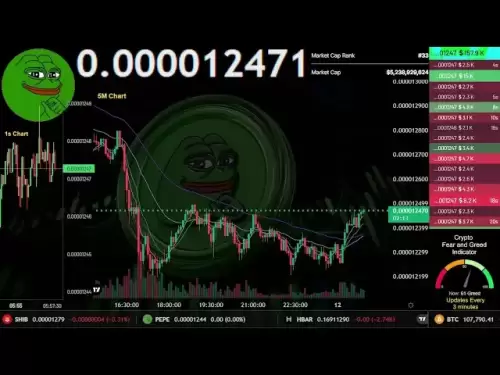-
 Bitcoin
Bitcoin $107,525.4151
-1.78% -
 Ethereum
Ethereum $2,735.6082
-4.05% -
 Tether USDt
Tether USDt $1.0001
0.01% -
 XRP
XRP $2.2422
-3.58% -
 BNB
BNB $662.7596
-0.79% -
 Solana
Solana $158.1687
-5.10% -
 USDC
USDC $0.9999
0.01% -
 Dogecoin
Dogecoin $0.1877
-7.49% -
 TRON
TRON $0.2747
-4.49% -
 Cardano
Cardano $0.6822
-5.47% -
 Hyperliquid
Hyperliquid $42.8962
-1.51% -
 Sui
Sui $3.3250
-4.95% -
 Chainlink
Chainlink $14.3884
-7.23% -
 Avalanche
Avalanche $21.0727
-6.00% -
 Bitcoin Cash
Bitcoin Cash $436.3853
-1.50% -
 Stellar
Stellar $0.2743
-2.67% -
 UNUS SED LEO
UNUS SED LEO $8.8628
-1.94% -
 Toncoin
Toncoin $3.1809
-3.06% -
 Shiba Inu
Shiba Inu $0.0...01261
-6.46% -
 Hedera
Hedera $0.1687
-4.92% -
 Litecoin
Litecoin $88.6994
-4.81% -
 Polkadot
Polkadot $4.0555
-5.96% -
 Monero
Monero $324.3593
-3.71% -
 Ethena USDe
Ethena USDe $1.0004
-0.02% -
 Bitget Token
Bitget Token $4.7112
-3.27% -
 Dai
Dai $0.9998
0.00% -
 Pepe
Pepe $0.0...01205
-9.02% -
 Uniswap
Uniswap $7.8362
-4.82% -
 Pi
Pi $0.6225
-2.58% -
 Aave
Aave $300.8914
-3.70%
How to diversify investments to reduce risks?
By diversifying investments across asset classes, industries, and geographies, investors can mitigate risks and enhance their overall portfolio performance.
Oct 24, 2024 at 10:06 am

How to Diversify Investments to Reduce Risks
In the realm of investing, diversification reigns supreme as a risk-reducing strategy. By spreading investments across various asset classes and industries, investors can minimize the impact of any single asset's performance on their overall portfolio. Here's a comprehensive guide on how to diversify investments to enhance your financial stability:
1. Establish Investment Goals and Risk Tolerance:
Before diversifying, clearly define your investment goals and risk tolerance. Consider your financial situation, time horizon, and comfort level with market fluctuations. This assessment will determine the appropriate balance of various asset classes in your portfolio.
2. Asset Class Diversification:
Diversify across asset classes, including stocks, bonds, real estate, commodities, and cash equivalents. Stocks represent ownership in companies and offer growth potential but also carry higher risk. Bonds provide fixed income but typically have lower returns. Real estate offers diversification and potential for appreciation but requires active management. Commodities are raw materials that can hedge against inflation. Cash equivalents, such as money market accounts and short-term CDs, provide stability and liquidity.
3. Industry Diversification:
Within each asset class, diversify across different industries. For example, in stocks, don't concentrate in just one sector like technology or healthcare. Instead, include stocks from various industries such as consumer goods, financials, and energy. This helps mitigate the risks associated with a single industry's performance.
4. Geographical Diversification:
Diversify internationally by including investments in companies and markets outside your home country. Global markets often have different economic cycles and risk profiles, reducing the likelihood that all markets will suffer a downturn simultaneously.
5. Investment Style Diversification:
Diversify by investment style within each asset class. For example, in stocks, consider a mix of growth stocks (companies with high growth potential), value stocks (companies with low valuations), and dividend stocks (companies that pay regular dividends). This diversification can capture various market conditions and reduce portfolio volatility.
6. Alternative Investments:
Consider alternative investments, such as hedge funds, private equity, and venture capital. These investments can provide further diversification and potentially enhance returns. However, they often come with higher risk and lower liquidity.
7. Regular Portfolio Rebalancing:
Periodically rebalance your portfolio to maintain your desired asset allocation. As market conditions change, the balance of your investments may shift, requiring adjustments to align with your investment goals and risk tolerance.
Conclusion:
Diversification is a crucial strategy for investors seeking to reduce risks and enhance portfolio performance. By following the steps outlined above, you can effectively distribute your investments across various asset classes, industries, geographical regions, investment styles, and alternative investments. This comprehensive approach will help you build a more resilient portfolio that can withstand market fluctuations and achieve your long-term financial objectives.
Disclaimer:info@kdj.com
The information provided is not trading advice. kdj.com does not assume any responsibility for any investments made based on the information provided in this article. Cryptocurrencies are highly volatile and it is highly recommended that you invest with caution after thorough research!
If you believe that the content used on this website infringes your copyright, please contact us immediately (info@kdj.com) and we will delete it promptly.
- Crypto Whale Accumulates 1.68M FARTCOIN Ahead of Coinbase Listing
- 2025-06-13 01:00:13
- Before Jack Butcher Became a Household Name in the NFT Ecosystem — Before Checks, Before Opepen
- 2025-06-13 01:00:12
- Maple Finance Launches stETH-Backed Credit Lines in Partnership with Lido Finance
- 2025-06-13 01:00:12
- Here's the weather forecast for Download 2025...
- 2025-06-13 00:57:14
- title: Former Kamala Harris 2024 Campaign Adviser David Plouffe Joins Coinbase's Global Advisory Council
- 2025-06-13 00:57:14
- Introducing “haSh,” a New Game That Democratizes Bitcoin Mining
- 2025-06-13 00:45:12
Related knowledge

Cryptocurrency K-line chart technical analysis manual: Learn these methods to increase your chances of making a profit
Jun 11,2025 at 11:21pm
Understanding the Basics of K-line ChartsK-line charts, also known as candlestick charts, are one of the most widely used tools in cryptocurrency trading. Each K-line represents a specific time period and provides information about the open, high, low, and close prices during that interval. The body of the candle shows the relationship between the openi...

The Importance of K-line Chart Analysis in Cryptocurrency Trading: From Theory to Practical Cases
Jun 11,2025 at 04:56pm
Understanding the Basics of K-line ChartsK-line charts, also known as candlestick charts, are a visual representation of price movements over specific time intervals. Each K-line encapsulates four critical data points: the opening price, closing price, highest price, and lowest price within a given timeframe. These charts originated in Japan during the ...

Cryptocurrency K-line Chart Interpretation Guide: How Novices Can Quickly Master the Basics of Technical Analysis
Jun 10,2025 at 08:56pm
Understanding the Basics of K-line ChartsK-line charts, also known as candlestick charts, are one of the most widely used tools in cryptocurrency trading for analyzing price movements. Each K-line represents a specific time period and shows the opening, closing, high, and low prices during that interval. For novices, grasping how to read these elements ...

Introduction to Cryptocurrency K-line Charts: How to Use Technical Analysis to Optimize Trading Decisions
Jun 12,2025 at 03:56pm
Understanding the Basics of K-line ChartsK-line charts, also known as candlestick charts, are one of the most essential tools used in cryptocurrency trading. Originating from Japan, these charts visually represent price movements over specific time intervals. Each candlestick displays four key pieces of information: the opening price, closing price, hig...

Practical Analysis of Cryptocurrency K-line Charts: How to Judge Market Sentiment through Charts
Jun 10,2025 at 09:42pm
Understanding the Basics of Cryptocurrency K-line ChartsCryptocurrency K-line charts, also known as candlestick charts, are essential tools for analyzing price movements in the crypto market. Each candlestick represents a specific time frame, such as 1 minute, 5 minutes, or even daily intervals. The structure of a K-line includes four key data points: o...

Detailed Explanation of Technical Analysis of Cryptocurrency K-line Charts: Master These Tools to Improve Trading Efficiency
Jun 12,2025 at 02:43am
Understanding Cryptocurrency K-line ChartsCryptocurrency K-line charts, also known as candlestick charts, are essential tools for traders aiming to interpret market behavior and make informed decisions. Each K-line represents a specific time period—such as 1 minute, 5 minutes, or 1 day—and displays the open, high, low, and close prices during that inter...

Cryptocurrency K-line chart technical analysis manual: Learn these methods to increase your chances of making a profit
Jun 11,2025 at 11:21pm
Understanding the Basics of K-line ChartsK-line charts, also known as candlestick charts, are one of the most widely used tools in cryptocurrency trading. Each K-line represents a specific time period and provides information about the open, high, low, and close prices during that interval. The body of the candle shows the relationship between the openi...

The Importance of K-line Chart Analysis in Cryptocurrency Trading: From Theory to Practical Cases
Jun 11,2025 at 04:56pm
Understanding the Basics of K-line ChartsK-line charts, also known as candlestick charts, are a visual representation of price movements over specific time intervals. Each K-line encapsulates four critical data points: the opening price, closing price, highest price, and lowest price within a given timeframe. These charts originated in Japan during the ...

Cryptocurrency K-line Chart Interpretation Guide: How Novices Can Quickly Master the Basics of Technical Analysis
Jun 10,2025 at 08:56pm
Understanding the Basics of K-line ChartsK-line charts, also known as candlestick charts, are one of the most widely used tools in cryptocurrency trading for analyzing price movements. Each K-line represents a specific time period and shows the opening, closing, high, and low prices during that interval. For novices, grasping how to read these elements ...

Introduction to Cryptocurrency K-line Charts: How to Use Technical Analysis to Optimize Trading Decisions
Jun 12,2025 at 03:56pm
Understanding the Basics of K-line ChartsK-line charts, also known as candlestick charts, are one of the most essential tools used in cryptocurrency trading. Originating from Japan, these charts visually represent price movements over specific time intervals. Each candlestick displays four key pieces of information: the opening price, closing price, hig...

Practical Analysis of Cryptocurrency K-line Charts: How to Judge Market Sentiment through Charts
Jun 10,2025 at 09:42pm
Understanding the Basics of Cryptocurrency K-line ChartsCryptocurrency K-line charts, also known as candlestick charts, are essential tools for analyzing price movements in the crypto market. Each candlestick represents a specific time frame, such as 1 minute, 5 minutes, or even daily intervals. The structure of a K-line includes four key data points: o...

Detailed Explanation of Technical Analysis of Cryptocurrency K-line Charts: Master These Tools to Improve Trading Efficiency
Jun 12,2025 at 02:43am
Understanding Cryptocurrency K-line ChartsCryptocurrency K-line charts, also known as candlestick charts, are essential tools for traders aiming to interpret market behavior and make informed decisions. Each K-line represents a specific time period—such as 1 minute, 5 minutes, or 1 day—and displays the open, high, low, and close prices during that inter...
See all articles

























































































